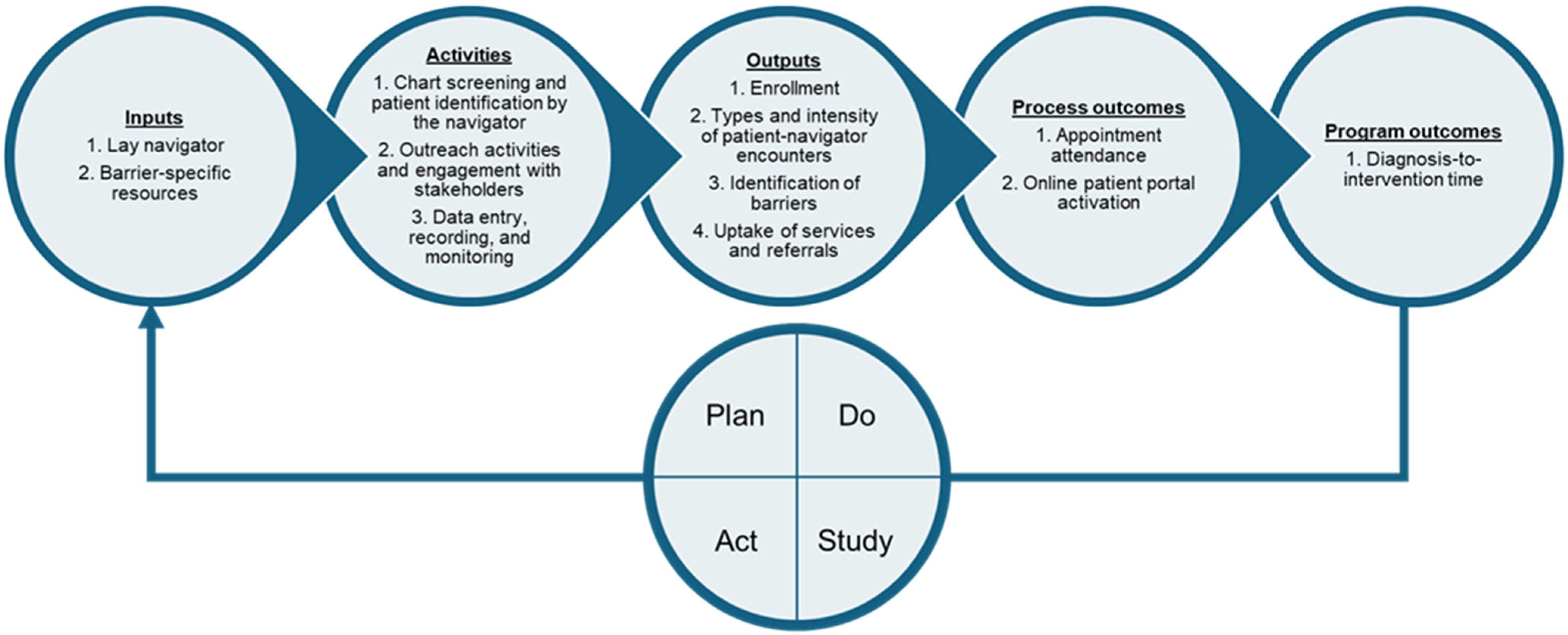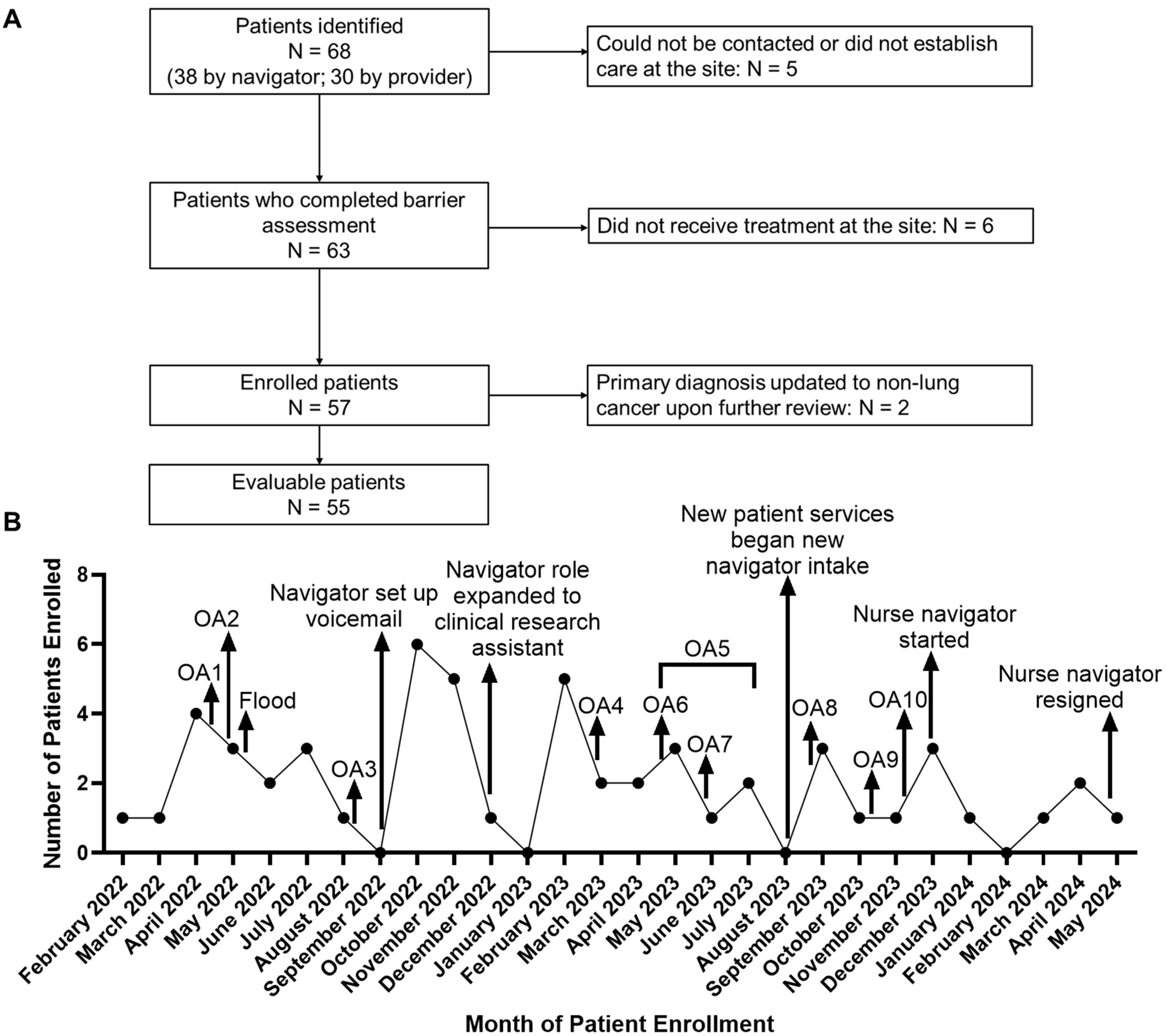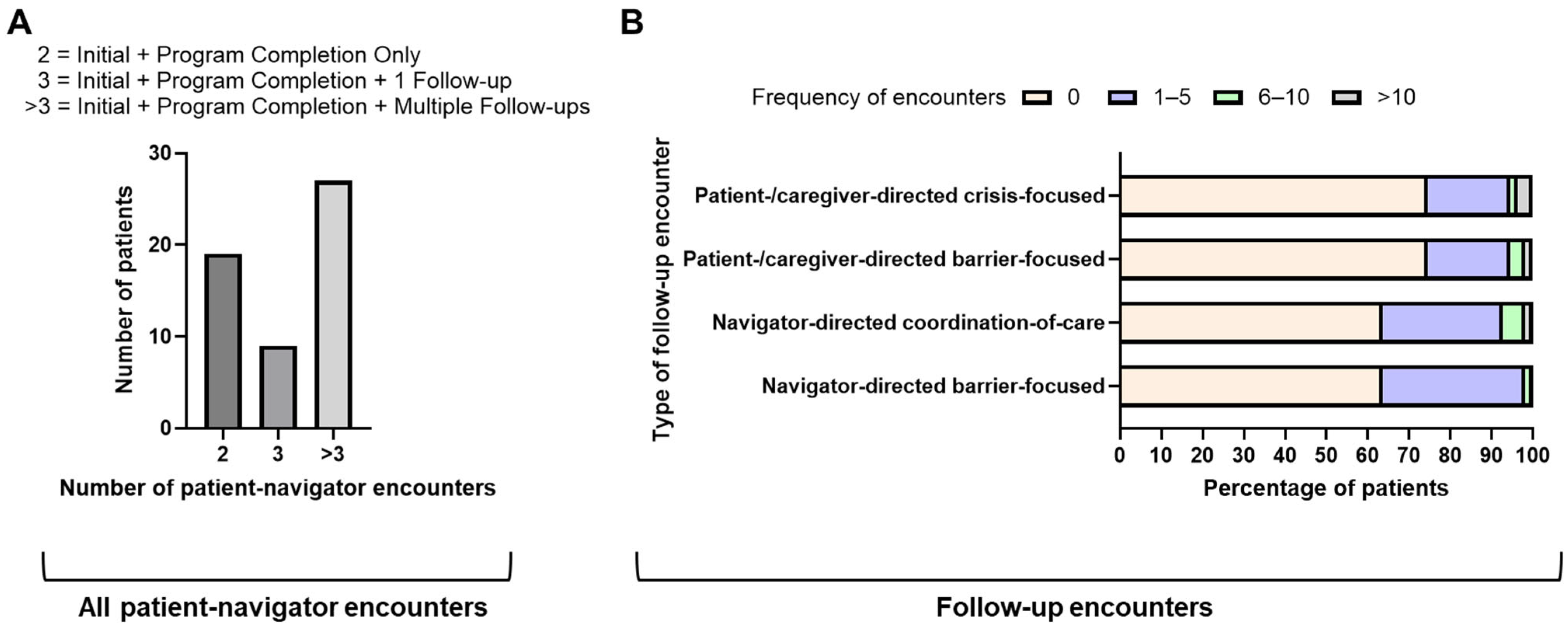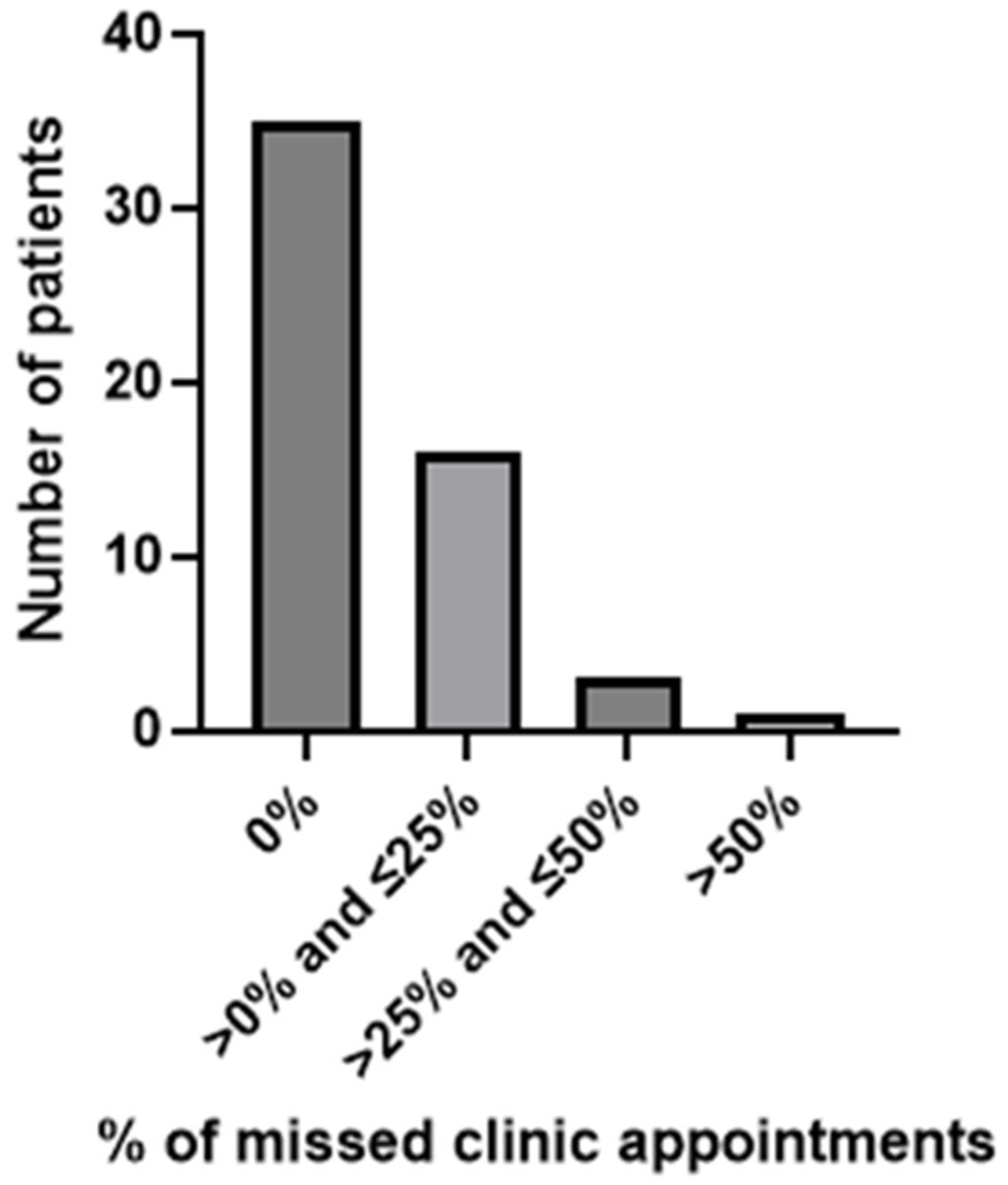Insights from a Patient-Centered Lung Cancer Navigation Program in a Low-Resource Community
Simple Summary
Abstract
1. Introduction
2. Methods
2.1. Setting
2.2. Intervention
2.3. Analysis
3. Results
3.1. Patient Enrollment
3.2. Patient Characteristics
3.3. Types of Patient–Navigator Encounters
3.4. Types and Frequency of Barriers to Care
3.5. Referrals and Resources Offered
3.6. Intensity of Patient–Navigator Encounters and Their Association with the Number of Barriers Identified
3.7. Patient Engagement
4. Discussion
5. Conclusions
Supplementary Materials
Author Contributions
Funding
Institutional Review Board Statement
Informed Consent Statement
Data Availability Statement
Acknowledgments
Conflicts of Interest
Abbreviations
| ADI | Area Deprivation Index |
| AV | Antelope Valley |
| CITI | Collaborative Institutional Training Initiative |
| COH | City of Hope |
| HIPAA | Health Insurance Portability and Accountability Act |
| PDSA | Plan-Do-Study-Act |
| QI | Quality Improvement |
References
- Freeman, H.P. The Origin, Evolution, and Principles of Patient Navigation. Cancer Epidemiol. Biomark. Prev. 2012, 21, 1614–1617. [Google Scholar] [CrossRef] [PubMed]
- Freeman, H.P.; Rodriguez, R.L. History and principles of patient navigation. Cancer 2011, 117, 3539–3542. [Google Scholar] [CrossRef] [PubMed]
- Freeman, H.P. A model patient navigation program: Breaking down barriers to ensure that all individuals with cancer receive timely diagnosis and treatment. Oncol. Issues 2004, 19, 44–46. [Google Scholar] [CrossRef]
- Paskett, E.D.; Harrop, J.P.; Wells, K.J. Patient navigation: An update on the state of the science. CA Cancer J. Clin. 2011, 61, 237–249. [Google Scholar] [CrossRef]
- Chang, B.L.; Bakken, S.; Brown, S.S.; Houston, T.K.; Kreps, G.L.; Kukafka, R.; Safran, C.; Stavri, P.Z. Bridging the Digital Divide: Reaching Vulnerable Populations. J. Am. Med. Inform. Assoc. 2004, 11, 448–457. [Google Scholar] [CrossRef]
- Hartman, L. Telehealth Use and Experiences Among California Adults; California Health Care Foundation (CHCF): Oakland, CA, USA, 2023; pp. 1–9. [Google Scholar]
- UCLA Center for Health Policy Research. 2024 California Health Interview Survey (CHIS): Making an Impact; UCLA Center for Health Policy Research: Los Angeles, CA, USA, 2024. [Google Scholar]
- Syed, S.T.; Gerber, B.S.; Sharp, L.K. Traveling towards disease: Transportation barriers to health care access. J. Community Health 2013, 38, 976–993. [Google Scholar] [CrossRef]
- Galperin, H.; Le, T.V. Statewide Broadband Adoption Survey: Internet Adoption and the Digital Divide in California; California Emerging Technology Fund (CETF) and University of Southern California (USC): Los Angeles, CA, USA, 2021; pp. 1–6. [Google Scholar]
- Rivera, M.P.; Katki, H.A.; Tanner, N.T.; Triplette, M.; Sakoda, L.C.; Wiener, R.S.; Cardarelli, R.; Carter-Harris, L.; Crothers, K.; Fathi, J.T.; et al. Addressing disparities in lung cancer screening eligibility and healthcare access. An official American Thoracic Society statement. Am. J. Respir. Crit. Care Med. 2020, 202, e95–e112. [Google Scholar] [CrossRef]
- Carter-Harris, L. Lung cancer stigma as a barrier to medical help-seeking behavior: Practice implications. J. Am. Assoc. Nurse Pract. 2015, 27, 240–245. [Google Scholar] [CrossRef]
- Rodriguez, E.; Olazagasti, C.; Khan, K.; Kareff, S.; Torres, T.; Torrents, S.; Fernandez-Vega Martinez, G.; MacIntyre, J.; Lopes, G. EP04.01-010 Addressing barriers to lung cancer care for diverse populations through patient navigation: The University of Miami experience. J. Thorac. Oncol. 2022, 17, S249–S250. [Google Scholar] [CrossRef]
- Lee, S.J.C.; Lee, J.; Zhu, H.; Chen, P.M.; Wahid, U.; Hamann, H.A.; Bhalla, S.; Cardenas, R.C.; Natchimuthu, V.S.; Johnson, D.H.; et al. Assessing barriers and facilitators to lung cancer screening: Initial findings from a patient navigation intervention. Popul. Health Manag. 2023, 26, 177–184. [Google Scholar] [CrossRef] [PubMed]
- Langballe, R.; Svendsen, L.; Jakobsen, E.; Dalton, S.O.; Karlsen, R.V.; Iachina, M.; Freund, K.M.; Leclair, A.; Jørgensen, L.B.; Skou, S.T.; et al. Nurse navigation, symptom monitoring and exercise in vulnerable patients with lung cancer: Feasibility of the NAVIGATE intervention. Sci. Rep. 2023, 13, 22744. [Google Scholar] [CrossRef] [PubMed]
- Lubuzo, B.; Ginindza, T.; Hlongwana, K. Exploring barriers to lung cancer patient access, diagnosis, referral and treatment in Kwazulu-Natal, South Africa: The health providers’ perspectives. Transl. Lung Cancer Res. 2019, 8, 380–391. [Google Scholar] [CrossRef]
- Committee on Quality of Health Care in America—Institute of Medicine. Crossing the Quality Chasm: A New Health System for the 21st Century; National Academy Press: Washington, DC, USA, 2001. [Google Scholar]
- Engle, R.L.; Mohr, D.C.; Holmes, S.K.; Seibert, M.N.; Afable, M.; Leyson, J.; Meterko, M. Evidence-based practice and patient-centered care: Doing both well. Health Care Manag. Rev. 2021, 46, 174–184. [Google Scholar] [CrossRef]
- Greene, S.M.; Tuzzio, L.; Cherkin, D. A framework for making patient-centered care front and center. Perm. J. 2012, 16, 49–53. [Google Scholar] [CrossRef]
- Johnston, D.; Sein, E.; Strusowski, T. Standardized evidence-based oncology navigation metrics for all models: A powerful tool in assessing the value and impact of navigation programs. J. Oncol. Navig. Surviv. 2017, 8, 220–237. [Google Scholar]
- Budde, H.; Williams, G.A.; Scarpetti, G.; Kroezen, M.; Maier, C.B. What Are Patient Navigators and How Can They Improve Integration of Care? European Observatory on Health Systems and Policies: Copenhagen, Denmark, 2022.
- Meade, C.D.; Wells, K.J.; Arevalo, M.; Calcano, E.R.; Rivera, M.; Sarmiento, Y.; Freeman, H.P.; Roetzheim, R.G. Lay Navigator Model for Impacting Cancer Health Disparities. J. Cancer Educ. 2014, 29, 449–457. [Google Scholar] [CrossRef] [PubMed][Green Version]
- Percac-Lima, S.; Ashburner, J.M.; Rigotti, N.A.; Park, E.R.; Chang, Y.; Kuchukhidze, S.; Atlas, S.J. Patient navigation for lung cancer screening among current smokers in community health centers a randomized controlled trial. Cancer Med. 2018, 7, 894–902. [Google Scholar] [CrossRef]
- Lorhan, S.; Dennis, D.; van der Westhuizen, M.; Hodgson, S.; Berrang, T.; Daudt, H. The experience of people with lung cancer with a volunteer-based lay navigation intervention at an outpatient cancer center. Patient Educ. Couns. 2014, 96, 237–248. [Google Scholar] [CrossRef]
- Haag, S.; Schaffer, J. Impact of virtual navigation on the education and access of patients with cancer: A national mixed methods investigation. SAGE Open Nurs. 2024, 10, 23779608241281132. [Google Scholar] [CrossRef]
- Pang, L.; Liu, Z.; Lin, S.; Liu, Z.; Liu, H.; Mai, Z.; Liu, Z.; Chen, C.; Zhao, Q. The effects of telemedicine on the quality of life of patients with lung cancer: A systematic review and meta-analysis. Ther. Adv. Chronic Dis. 2020, 11, 204062232096159. [Google Scholar] [CrossRef] [PubMed]
- US Department of Health and Human Services. What Is Telehealth? Available online: https://www.hhs.gov/hipaa/for-professionals/faq/3015/what-is-telehealth/index.html (accessed on 11 August 2025).
- Bhatt, J.; Bathija, P. Ensuring access to quality health care in vulnerable communities. Acad. Med. 2018, 93, 1271–1275. [Google Scholar] [CrossRef] [PubMed]
- Ogrinc, G.; Davies, L.; Goodman, D.; Batalden, P.; Davidoff, F.; Stevens, D. SQUIRE 2.0 (Standards for QUality Improvement Reporting Excellence): Revised publication guidelines from a detailed consensus process. Am. J. Med. Qual. 2015, 30, 543–549. [Google Scholar] [CrossRef] [PubMed]
- Los Angeles County Department of Public Health. Key Indicators of Health by Service Planning Area; Los Angeles County Department of Public Health: Los Angeles, CA, USA, 2017.
- Ramaswamy, R.; Shidhaye, R.; Nanda, S. Making complex interventions work in low resource settings: Developing and applying a design focused implementation approach to deliver mental health through primary care in India. Int. J. Ment. Health Syst. 2018, 12, 5. [Google Scholar] [CrossRef] [PubMed]
- van Zyl, C.; Badenhorst, M.; Hanekom, S.; Heine, M. Unravelling ‘low-resource settings’: A systematic scoping review with qualitative content analysis. BMJ Glob. Health 2021, 6, e005190. [Google Scholar] [CrossRef]
- County of Los Angeles. 2020 Census Antelope Valley; County of Los Angeles: Los Angeles, CA, USA, 2020.
- Los Angeles County Department of Public Health. City and Community Health Profiles: Lancaster; Los Angeles County Department of Public Health: Los Angeles, CA, USA, 2018.
- CITI Program. CITI Training Human Subjects Research. Available online: https://about.citiprogram.org/series/human-subjects-research-hsr/ (accessed on 26 October 2024).
- Fouad, M.N.; Johnson, R.E.; Nagy, M.C.; Person, S.D.; Partridge, E.E. Adherence and retention in clinical trials: A community-based approach. Cancer 2014, 120 (Suppl. 7), 1106–1112. [Google Scholar] [CrossRef]
- Gallups, S.F.; Demirci, J.; Nilsen, M.L.; Burke, J.; Bender, C.; Rosenzweig, M.Q. Stakeholder perspectives on six identified interpersonal communication components of patient navigation in breast cancer care. Support. Care Cancer 2023, 31, 688. [Google Scholar] [CrossRef]
- Epic®. Epic® Health System Community. Available online: https://www.epic.com/ (accessed on 23 April 2025).
- Harris, P.A.; Taylor, R.; Thielke, R.; Payne, J.; Gonzalez, N.; Conde, J.G. Research electronic data capture (REDCap)—A metadata-driven methodology and workflow process for providing translational research informatics support. J. Biomed. Inform. 2009, 42, 377–381. [Google Scholar] [CrossRef]
- Harris, P.A.; Taylor, R.; Minor, B.L.; Elliott, V.; Fernandez, M.; O’Neal, L.; McLeod, L.; Delacqua, G.; Delacqua, F.; Kirby, J.; et al. The REDCap consortium: Building an international community of software platform partners. J. Biomed. Inform. 2019, 95, 103208. [Google Scholar] [CrossRef]
- Johnson, K.; Gustafson, D.; Ewigman, B.G.; Provost, L.; Roper, R. Using Rapid-Cycle Research to Reach Goals: Awareness, Assessment, Adaptation, Acceleration; U.S. Department of Health and Human Services: Rockville, MA, USA, 2015.
- Cantiello, J.; Kitsantas, P.; Moncada, S.; Abdul, S. The evolution of quality improvement in healthcare: Patient-centered care and health information technology applications. J. Hosp. Adm. 2016, 5, 62–68. [Google Scholar] [CrossRef]
- Freund, K.M.; Haas, J.S.; Lemon, S.C.; Burns White, K.; Casanova, N.; Dominici, L.S.; Erban, J.K.; Freedman, R.A.; James, T.A.; Ko, N.Y.; et al. Standardized activities for lay patient navigators in breast cancer care: Recommendations from a citywide implementation study. Cancer 2019, 125, 4532–4540. [Google Scholar] [CrossRef]
- Freund, K.M.; Battaglia, T.A.; Calhoun, E.; Dudley, D.J.; Fiscella, K.; Paskett, E.; Raich, P.C.; Roetzheim, R.G. National Cancer Institute Patient Navigation Research Program: Methods, protocol, and measures. Cancer 2008, 113, 3391–3399. [Google Scholar] [CrossRef]
- Kind, A.J.H.; Buckingham, W.R. Making neighborhood-disadvantage metrics accessible—The Neighborhood Atlas. N. Engl. J. Med. 2018, 378, 2456–2458. [Google Scholar] [CrossRef]
- Carroll, J.K.; Winters, P.C.; Purnell, J.Q.; Devine, K.; Fiscella, K. Do navigators’ estimates of navigation intensity predict navigation time for cancer care? J. Cancer Educ. 2011, 26, 761–766. [Google Scholar] [CrossRef]
- LaVeist, T.A. Beyond dummy variables and sample selection: What health services researchers ought to know about race as a variable. Health Serv. Res. 1994, 29, 1–16. [Google Scholar]
- Davis, M.M.; Bruckman, D.; Cabana, M.D.; Clark, S.J.; Dombkowski, K.J.; Kemper, A.R.; Rushton, J.L.; Freed, G.L. Constructive use of race and ethnicity variables. Arch. Pediatr. Adolesc. Med. 2001, 155, 973–974. [Google Scholar] [PubMed]
- Kaplan, J.B.; Bennett, T. Use of Race and Ethnicity in Biomedical Publication. JAMA 2003, 289, 2709–2716. [Google Scholar] [CrossRef]
- Amutah, C.; Greenidge, K.; Mante, A.; Munyikwa, M.; Surya, S.L.; Higginbotham, E.; Jones, D.S.; Lavizzo-Mourey, R.; Roberts, D.; Tsai, J.; et al. Misrepresenting race—The role of medical schools in propagating physician bias. N. Engl. J. Med. 2021, 384, 872–878. [Google Scholar] [CrossRef]
- Kratzer, T.B.; Bandi, P.; Freedman, N.D.; Smith, R.A.; Travis, W.D.; Jemal, A.; Siegel, R.L. Lung cancer statistics, 2023. Cancer 2024, 130, 1330–1348. [Google Scholar] [CrossRef]
- Pinsky, P.F.; Lau, Y.K.; Doubeni, C.A. Potential disparities by sex and race or ethnicity in lung cancer screening eligibility rates. Chest 2021, 160, 341–350. [Google Scholar] [CrossRef] [PubMed]
- Zullig, L.L.; Jackson, G.L.; Provenzale, D.; Griffin, J.M.; Phelan, S.; van Ryn, M. Transportation: A vehicle or roadblock to cancer care for VA patients with colorectal cancer? Clin. Color. Cancer 2012, 11, 60–65. [Google Scholar] [CrossRef] [PubMed]
- Graboyes, E.M.; Chaiyachati, K.H.; Sisto Gall, J.; Johnson, W.; Krishnan, J.A.; McManus, S.S.; Thompson, L.; Shulman, L.N.; Yabroff, K.R. Addressing transportation insecurity among patients with cancer. JNCI J. Natl. Cancer Inst. 2022, 114, 1593–1600. [Google Scholar] [CrossRef]
- Rocque, G.B.; Taylor, R.A.; Acemgil, A.; Li, X.; Pisu, M.; Kenzik, K.; Jackson, B.E.; Halilova, K.I.; Demark-Wahnefried, W.; Meneses, K.; et al. Guiding lay navigation in geriatric patients with cancer using a distress assessment tool. J. Natl. Compr. Cancer Netw. 2016, 14, 407–414. [Google Scholar] [CrossRef]
- Chávarri-Guerra, Y.; Ramos-López, W.A.; Covarrubias-Gómez, A.; Sánchez-Román, S.; Quiroz-Friedman, P.; Alcocer-Castillejos, N.; Del Pilar Milke-García, M.; Carrillo-Soto, M.; Morales-Alfaro, A.; Medina-Palma, M.; et al. Providing supportive and palliative care using telemedicine for patients with advanced cancer during the COVID-19 pandemic in Mexico. Oncologist 2021, 26, e512–e515. [Google Scholar] [CrossRef]
- Acuity: The critical measure in navigation. J. Oncol. Navig. Surviv. 2020, 11. Available online: https://www.jons-online.com/issues/2020/june-2020-vol-11-no-6/acuity-the-critical-measure-in-navigation (accessed on 11 August 2025).
- Chan, R.J.; Milch, V.E.; Crawford-Williams, F.; Agbejule, O.A.; Joseph, R.; Johal, J.; Dick, N.; Wallen, M.P.; Ratcliffe, J.; Agarwal, A.; et al. Patient navigation across the cancer care continuum: An overview of systematic reviews and emerging literature. CA Cancer J. Clin. 2023, 73, 565–589. [Google Scholar] [CrossRef]
- Hendren, S.; Chin, N.; Fisher, S.; Winters, P.; Griggs, J.; Mohile, S.; Fiscella, K. Patients’ barriers to receipt of cancer care, and factors associated with needing more assistance from a patient navigator. J. Natl. Med. Assoc. 2011, 103, 701–710. [Google Scholar] [CrossRef] [PubMed]
- Matthews, A.K.; Steffen, A.D.; Burke, L.A.; Donenberg, G.; Duangchan, C.; Akufo, J.; Opuada, H.; Oyaluade, D.; Vilona, B.H.; Diaz, H.; et al. The use of navigators to increase patient portal enrollment among patients in a federally qualified health care system. Ethn. Dis. 2024, 117–125. [Google Scholar] [CrossRef] [PubMed]
- Fuemmeler, B.F.; Shen, J.; Zhao, H.; Winn, R. Neighborhood deprivation, racial segregation and associations with cancer risk and outcomes across the cancer-control continuum. Mol. Psychiatry 2023, 28, 1494–1501. [Google Scholar] [CrossRef]
- Goel, N.; Hernandez, A.E.; Mazul, A. Neighborhood disadvantage and breast cancer-specific survival in the US. JAMA Netw. Open 2024, 7, e247336. [Google Scholar] [CrossRef] [PubMed]
- Beck, A.F.; Sandel, M.T.; Ryan, P.H.; Kahn, R.S. Mapping neighborhood health geomarkers to clinical care decisions to promote equity in child health. Health Aff. 2017, 36, 999–1005. [Google Scholar] [CrossRef]
- Bazemore, A.W.; Cottrell, E.K.; Gold, R.; Hughes, L.S.; Phillips, R.L.; Angier, H.; Burdick, T.E.; Carrozza, M.A.; DeVoe, J.E. “Community vital signs”: Incorporating geocoded social determinants into electronic records to promote patient and population health. J. Am. Med. Inform. Assoc. 2016, 23, 407–412. [Google Scholar] [CrossRef] [PubMed]
- Marshall, R.; Bradbury, A.; Morgan, N.; Pineda, K.; Hayes, D.; Burton, A.; Sonke, J.; Fancourt, D. Social prescribing in the USA: Emerging learning and opportunities. Lancet Public Health 2025, 10, e531–e536. [Google Scholar] [CrossRef] [PubMed]
- Lin, M.C.; Park, G.; Ashe, M.C. Integrating social prescribing in a Canadian regional health system to support healthy aging. Health Promot. Chronic Dis. Prev. Can. 2024, 44, 392–396. [Google Scholar] [CrossRef]
- Niemann, A.L.; Million, R.M. Addressing social isolation and loneliness in older adults at the health plan level: A quality improvement project. Geriatr. Nurs. 2023, 53, 307–309. [Google Scholar] [CrossRef] [PubMed]
- Jean-Pierre, P.; Fiscella, K.; Winters, P.C.; Post, D.; Wells, K.J.; McKoy, J.M.; Battaglia, T.; Simon, M.A.; Kilbourn, K. Psychometric development and reliability analysis of a patient satisfaction with interpersonal relationship with navigator measure: A multi-site patient navigation research program study. Psychooncology 2012, 21, 986–992. [Google Scholar] [CrossRef] [PubMed]





| Demographic/Clinical Information | Number of Evaluable Patients (N = 55) |
|---|---|
| Gender-N (%) | |
| Male | 24 (43.6%) |
| Female | 31 (56.4%) |
| Age (years) | |
| Median | 71 |
| Population Distribution by Age-N (%) | |
| <65 years | 13 (23.6%) |
| ≥65 years | 42 (76.4%) |
| Race-N (%) | |
| Black | 7 (12.7%) |
| White | 46 (83.6%) |
| Unknown | 2 (3.6%) |
| Ethnicity-N (%) | |
| Hispanic or Latino | ≤5 (≤9.1%) |
| Not Hispanic or Latino | 50 (90.9%) |
| Unknown | ≤5 (≤9.1%) |
| Smoking Status-N (%) | |
| Current | 15 (27.3%) |
| Former | 32 (58.2%) |
| Never | 8 (14.5%) |
| Diagnosis-N (%) | |
| High-risk lung nodule/mass with no cancer diagnosis | 17 (30.9%) |
| Lung cancer | 38 (69.1%) |
| Lung Cancer Stage-N (%) | |
| I | 9 (23.7%) |
| II | 7 (18.4%) |
| III | 9 (23.7%) |
| IV | 13 (34.2%) |
| Patient Travel Distance (miles)-Median (Interquartile Range) | |
| Residence to COH-AV | 26 (14–58) |
| Residence to COH-Duarte | 93 (82–122) |
| Population Distribution by Travel Distance-N (%) | |
| Residence to COH-AV ≤ 50 miles | 41 (74.5%) |
| Residence to COH-AV > 50 miles | 14 (25.5%) |
| Residence to COH-Duarte ≤ 50 miles | ≤5 (≤9.1%) |
| Residence to COH-Duarte > 50 miles | ≥50 (≥90.9%) |
| Patient Category | Total Number of Enrolled Patients N (%) N = 55 |
|---|---|
| Patients who had ≥1 barrier | 33 (60.0%) |
| Barriers for which referrals were offered | |
| Patients with psychosocial concerns | |
| Concerned about paying rent/mortgage | ≤5 (≤9.1%) |
| Has childcare responsibilities | ≤5 (≤9.1%) |
| Needs to talk to a mental health professional | 9 (16.4%) |
| Is the primary caretaker of someone disabled or elderly | ≤5 (≤9.1%) |
| Concerned about current living situation | ≤5 (≤9.1%) |
| Patients with financial concerns about paying for medical care | 13 (23.6%) |
| Patients who are current smokers | 15 (27.3%) |
| Patients with barriers who were offered ≥1 referral | 31 (56.4%) |
| Barriers for which resources were offered | |
| Patients with Internet access concerns # | 13 (23.6%) |
| Patients with transportation concerns | 17 (30.9%) |
| Patients with barriers who received resources | |
| Loaner iPad®s | 5 (38.5%) |
| Gas-Gift Cards | 12 (70.6%) |
Disclaimer/Publisher’s Note: The statements, opinions and data contained in all publications are solely those of the individual author(s) and contributor(s) and not of MDPI and/or the editor(s). MDPI and/or the editor(s) disclaim responsibility for any injury to people or property resulting from any ideas, methods, instructions or products referred to in the content. |
© 2025 by the authors. Licensee MDPI, Basel, Switzerland. This article is an open access article distributed under the terms and conditions of the Creative Commons Attribution (CC BY) license (https://creativecommons.org/licenses/by/4.0/).
Share and Cite
Phillips, T.; Kothari, A.; Robison, A.; Erfe, J.M.; Raz, D.J. Insights from a Patient-Centered Lung Cancer Navigation Program in a Low-Resource Community. Curr. Oncol. 2025, 32, 491. https://doi.org/10.3390/curroncol32090491
Phillips T, Kothari A, Robison A, Erfe JM, Raz DJ. Insights from a Patient-Centered Lung Cancer Navigation Program in a Low-Resource Community. Current Oncology. 2025; 32(9):491. https://doi.org/10.3390/curroncol32090491
Chicago/Turabian StylePhillips, Tanyanika, Anjaney Kothari, Africa Robison, Jeffrey Mark Erfe, and Dan J. Raz. 2025. "Insights from a Patient-Centered Lung Cancer Navigation Program in a Low-Resource Community" Current Oncology 32, no. 9: 491. https://doi.org/10.3390/curroncol32090491
APA StylePhillips, T., Kothari, A., Robison, A., Erfe, J. M., & Raz, D. J. (2025). Insights from a Patient-Centered Lung Cancer Navigation Program in a Low-Resource Community. Current Oncology, 32(9), 491. https://doi.org/10.3390/curroncol32090491





